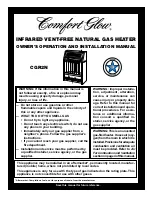
Premier Ductable Heater
www.lbwhite.com
Owner’s Manual • Premier Ductable Heater
10
-- Check all pipe connections, hose connections, fittings
and adapters upstream of the gas control with approved
gas leak detectors.
-- In the event a gas leak is detected, check the compo-
nents involved for cleanliness and proper application of
pipe compound before further tightening.
-- Tighten the gas connections as necessary to stop the
leak.
-- After all connections are checked and any leaks are
stopped, turn on the main burner.
-- Stand clear while the main burner ignites to prevent
injury caused from hidden leaks that could cause
flashback.
-- With the main burner in operation, check all connec-
tions, hose connections, fittings and joints as well as
the gas control valve inlet and outlet connections with
approved gas leak detectors.
-- If a leak is detected, check the components involved for
cleanliness in the thread areas and proper application of
pipe compound before further tightening.
-- Tighten the gas connection as necessary to stop the
leak.
-- If necessary, replace the parts or components involved
if the leak cannot be stopped.
-- Ensure all gas leaks have been identified and repaired
before proceeding.
9. A qualified service technician must check for proper
operating gas pressure upon installation of the heater.
10. Light according to instructions on heater or within
owner’s manual.
11. The heater must have the proper gas regulator for the
application. Use only the L.B. White regulator originally
supplied with the heater. This regulator includes a POL
fitting incorporating an excess flow valve. The excess
flow valve is a safety device which protects against
discharge from the propane gas supply container if
the regulator is broken off. If the POL fitting is ever
replaced, it needs to be replaced with an L.B. White
POL fitting. Failure to do so can result in fires, explo
-
sions, loss of property, injury or death.
12. A regulator must be connected to the gas supply so
that the pressure to the inlet of the gas
control valve is regulated within the range
specified on the dataplate at all times. Contact your
gas supplier or the L.B. White Co., LLC if you have
any questions.
13. Do not use the heater in an propane gas liquid
withdrawal system or application. If you are in doubt,
contact your local fuel gas suppler or the L.B. White
Co., LLC.
14. The heater must be installed so as not to
interfere with or obstruct normal exits,
emergency exits, doors and walkways.
15. Railing, fencing or suitable substitute materials must
be used to keep the heating equipment from any
people using and visiting the structure.
16. The unit shall be located so that rain, ice, or snow
drainage from the structure does not affect equipment
operation. If the unit is mounted
outside, it must be mounted above any pooled or
standing water. If the unit is to be located on the
ground, a surrounding trench is
recommended to drain any rain, ice or snow away
from the unit.
17. The ground and surrounding terrain must be cleared
of any combustible vegetation and other combustible
materials when the heater is mounted outside.
18. Thermostat failure may result in an underheating
condition. The thermostat should be tested to make
sure it turns the heater on and off within a tempera-
ture differential of ±3°F (±1.5 °C).
19. Take time to understand how to operate and maintain
the heater by using this Owner’s Manual. Make sure
you know how to shut off the gas supply to the build-
ing and also to the individual heater. Contact your fuel
gas supplier if you have any questions.
20. Any defects found in performing any of the service or
maintenance procedures must be
corrected and defective parts replaced
immediately. The heater must be evaluated by a
qualified service technician before placing the heater
back into use.
WARNING
Fire and Explosion Hazard
■ Do not use open flame (matches, torches,
candles, etc.) in checking for gas leaks.
■ Use only approved leak detectors.
■ Failure to follow this warning can lead to fires
or explosions.
■ Fires or explosions can lead to property
damage, personal injury or loss of life.











































